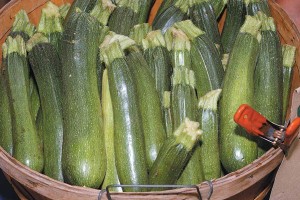If you’ve ever planted zucchini, you know that it grows wild. You know the stress of figuring out what to do with all of the zucchini you’ve harvested. You can only make so many loaves of zucchini bread until you’re sick of it. And you can only give so many vegetables away to the same neighbors, friends and family.
Have you ever thought about freezing zucchini to use later in the year? The National Center for Home Food Preservation explains how.
How to freeze zucchini
- Only use zucchini that are young and have tender skin.
A season’s worth of zucchini goes a long way. - Wash each zucchini.
- Cut each zucchini into ½-inch slices.
- Water blanch the zucchini. Bring a pot of water to a boil on the stove. One gallon per one pound of vegetables is the rule of thumb. Keep the heat high once you add the zucchini to the boiling water. Blanch for 3 minutes.
- Cool the zucchini. This can be done by putting the zucchini in a bowl of ice water.
- Drain the zucchini.
- Put zucchini in plastic resealable freezer storage bags or containers, leaving ½-inch of room at the top of each bag or container.
- Seal the bags or containers and put in the freezer.
How to freeze grated zucchini
If you want to freeze grated zucchini for baking, follow these steps:
- Only use zucchini that are young and have tender skin.
- Wash each zucchini.
- Grate each zucchini.
- Steam blanch the zucchini. Put a couple of inches of water in a pot with a tight-fitting lid, then bring it to a boil. Place grated zucchini in a single layer in a basket that holds the vegetables at least 3 inches above the bottom of the pot. Cover the pot with the heat on high.
- Steam blanch for 1-2 minutes. The zucchini will be translucent once it is blanched.
- Put zucchini in plastic resealable freezer storage bags or containers, leaving ½-inch of room at the top of each bag or container.
- Place the bags or containers in cold water to cool.
- Seal the bags or containers and put in the freezer.
Source: The National Center for Home Food Preservation
Get more Great Recipes in your inbox each week by getting
Around the Table.
It's a FREE weekly e-newsletter all about food. Sign Up Today!


















